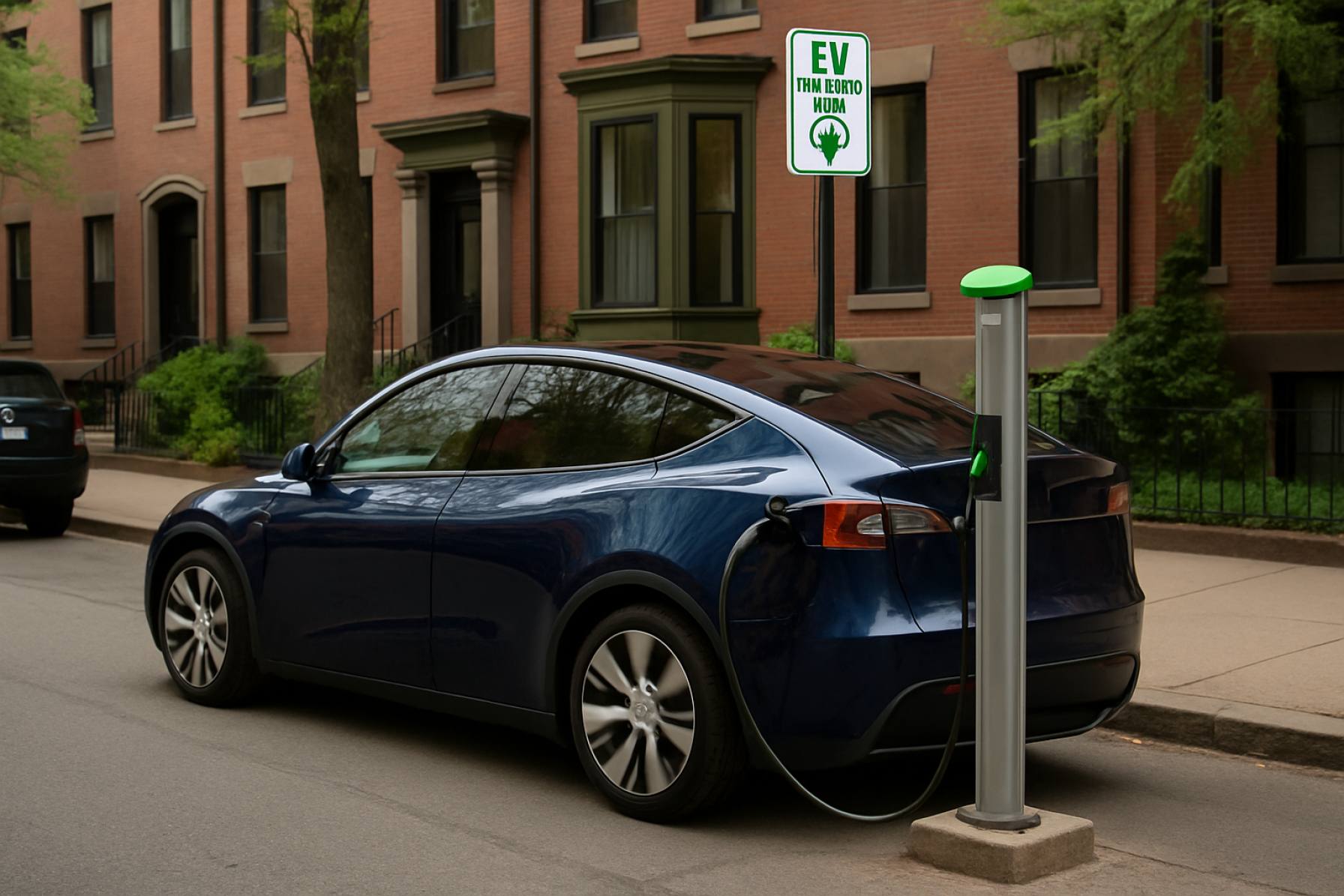- Boston is gradually installing nearly two dozen curbside EV charging stations, prioritizing public areas and transit corridors.
- Strategic placement aims to maximize accessibility for electric vehicle drivers while preserving the character of historic neighborhoods.
- Some chargers will be city-operated, while others will involve private firms, demonstrating a public-private partnership approach.
- The expansion of EV infrastructure is essential to meeting Massachusetts’ climate goals, including a 50% emissions reduction by 2030 and deploying one million EVs by 2035.
- The new stations are expected to increase EV adoption, support property values, and reduce range anxiety—but installation may not be complete until late 2025 or early 2026.
Beneath a patch of weathered sidewalk on Gordon Street, an unassuming sign hints at a quiet revolution just on the horizon. Electric vehicles—once a rarity, now an emblem of Boston’s greener ambitions—will soon have new homes for their nightly charge, but the wait may test residents’ patience.
The city is orchestrating a careful rollout of nearly two dozen curbside EV charging stations, targeting streets adjacent to bustling public spaces and transit lines. The vision: to reshape how Bostonians refuel and reimagine their relationship with cars. But excitement gives way to realism as neighbors learn the first chargers on Gordon Street and Lamartine Street might not spark to life until late 2025 or the frosty first days of 2026.
Boston’s deliberate pace isn’t for lack of enthusiasm. City planners are threading a needle—strategically placing chargers away from residential facades, ensuring access for everyone without disrupting the character of historic neighborhoods. Some stations will take on the city’s blue-and-white livery, operated by public hands, while others will bear the badge of private firms, alleviating municipal budgets while stitching public-private ambition into the city’s streetscape.
The drive for more electric vehicles isn’t merely local posturing. Massachusetts, like much of the Northeast, has set ambitious climate targets, and transportation remains one of the leading sources of greenhouse gas emissions. Expanding accessible charging networks is critical for meeting the Commonwealth’s pledge to cut emissions by 50 percent by 2030 and put a million electric vehicles on the road by 2035.
These new stations—visible harbingers of policy—have ripple effects beyond convenience. Their presence can influence neighborhood adoption rates, boost real estate values, and ease the anxiety of would-be EV drivers hamstrung by “range anxiety.” Yet as one strolls near Green Street MBTA, it’s impossible to ignore the paradox: transformation is coming, but electricity still waits to flow.
Want to track Boston’s progress and broader climate commitments? Visit Boston.gov for details on infrastructure, sustainability, and the city’s evolving landscape.
The key takeaway: Boston is making deliberate, strategic moves to green its streets—but real change takes time, patience, and a vision that is both ambitious and adaptable. Watch for the quiet arrival of these curbside stations—they’re charging the city’s future, one block at a time.
Boston’s Bold Electric Shift: What EV Charging Will Really Mean for You, Home Values & the City’s Future
Boston’s rollout of curbside electric vehicle (EV) chargers marks a historic shift in its urban landscape and sustainability ambitions. But behind the headlines lie deeper facts, insights, and lingering questions that impact residents, businesses, and investors alike.
Boston’s Curbside Charger Rollout: What You Need to Know
Additional Facts & Industry Context
– National & Regional Growth: Across the U.S., the number of public EV charging ports has doubled since 2020, with the Northeast leading in urban charger deployment ([DOE Alternative Fuels Data Center](https://afdc.energy.gov)). Boston’s plans align with state and federal goals to accelerate clean transportation.
– Types of Chargers: Expect Level 2 chargers—offering about 20–25 miles of range per hour. Fast DC chargers, typically found on highways, are rare in city curbside programs due to electrical and cost constraints.
– Ownership & Pricing: Publicly-run chargers may offer hourly rates ($1–2/hr), while privately operated ones might use per-kWh pricing. Expect price variation as the network grows.
– Integration with Public Transit: Locating chargers near MBTA lines targets “multimodal” commuters—those who drive but also use public transport, encouraging car-light lifestyles.
– Grid Upgrades & Sustainability: Installing dozens of curbside units requires grid reinforcement and sometimes transformer upgrades, part of a long-term grid modernization effort.
– Historic Preservation Concerns: Boston’s Landmarks Commission often reviews projects close to historic buildings, influencing charger design and placement.
Pressing Reader Questions
– How Will Charger Availability Affect Home Values?
– Multiple studies (e.g., Realtor.com, 2023) show homes near public EV chargers see increased demand and, in some neighborhoods, command up to a 3% premium.
– Will These Chargers Be Open 24/7?
– Most curbside stations plan for 24/7 access, with time limits (e.g., 4 hours max) to prevent overnight hogging.
– Can Renters Use These Stations, or Only Homeowners?
– Curbside chargers are a game-changer for renters or condo dwellers with no private driveway or garage access, broadening EV adoption citywide.
– How Do I Begin Using a Curbside Charger?
1. Find stations via apps like PlugShare or ChargePoint.
2. Download the specified charging app or use NFC credit card tap.
3. Plug in, follow on-screen instructions, and monitor progress on your phone.
– How Does Boston Compare to Peer Cities?
– New York and San Francisco currently outpace Boston in curbside deployments per capita. However, Boston’s hybrid public-private model is seen as financially resilient and adaptable ([ICF International](https://icf.com)).
Real-World Use Cases
– Rideshare & Delivery Drivers: Reliable curbside charging reduces downtime, a critical factor for gig economy professionals.
– Small Businesses: Proximity to chargers can attract EV-driving customers and employees, boosting local commerce.
– Tourism: EV infrastructure is increasingly recognized by eco-conscious travelers choosing destinations.
Market Forecasts & Trends
– Rising EV Adoption: With Massachusetts targeting 1 million EVs by 2035, charging demand is expected to increase 20%+ annually (Boston Consulting Group).
– Charger Tech Advances: Expect more stations in coming years to add features like real-time availability tracking and dynamic pricing.
– Federal Funding Impact: Biden’s Infrastructure Law delivers $7.5B nationally for EV infrastructure—Boston will likely benefit further.
Controversies & Limitations
– Equity Concerns: Watchdog groups note that wealthier, whiter neighborhoods often get chargers first. Boston officials say future rollout phases will prioritize equity gaps.
– Street Parking Tension: Some residents worry chargers will reduce general parking spots, sparking local disputes.
– Range Limits: Level 2 chargers, while cost-effective, don’t rapidly refuel EVs, making them less ideal for taxis or ride-hailing fleets with high daily mileage.
Features, Specs & Pricing Overview
– Typical Specs:
– Charging Speed: 6.6–7.2 kW (Level 2)
– Cable Length: 18–25 feet
– Payment: Mobile app, credit/debit tap, sometimes contactless public ID
– ADA Compliance: Stations designed for wheelchair and mobility device access
– Pricing:
– $0.15 to $0.30 per kWh is typical, but pilot programs may offer discounted or free charging at first.
Security & Sustainability
– Chargers feature tamper-resistant enclosures and built-in surge protection.
– Most are sited away from direct home facades to minimize light and noise.
– Integration with sustainable energy sources (solar, grid battery) is on the horizon for future phases.
Insights & Predictions
– Adoption Chain Reaction: Once visible in neighborhoods, data shows a 25% rise in EV interest within one year ([Rocky Mountain Institute](https://rmi.org)).
– Home Charging Remains King: Curbside is critical for those without driveways, but most EV miles are still refueled at home or work.
Pros & Cons Overview
Pros:
– Increases EV adoption equity for renters
– Can boost property and neighborhood values
– Supports climate and air quality goals
Cons:
– May reduce general parking
– Not as fast as highway “superchargers”
– Initial delays may frustrate early adopters
Actionable Recommendations & Quick Life Hacks
– For EV Owners: Download and test charging locator apps now; set up accounts with major network providers in advance.
– For Renters: Contact your landlord and neighborhood association to advocate for more EV chargers in your area.
– For Businesses: Consider co-sponsoring Wi-Fi or wayfinding signs at charger sites to tap into EV-driven foot traffic.
– For All Residents: Visit Boston.gov and sign up for city EV infrastructure alerts to help shape deployments in your community.
Bottom Line: Boston’s deliberate, strategic rollout represents not just a sustainability milestone, but an economic and mobility opportunity for nearly every resident. Start planning now to make the most of this electrified future—whether you drive, rent, own, or simply want cleaner air on your block.









